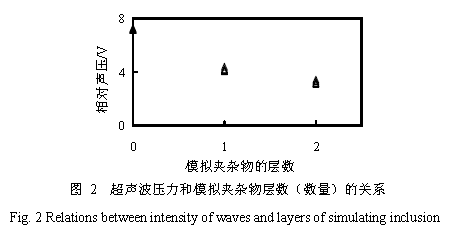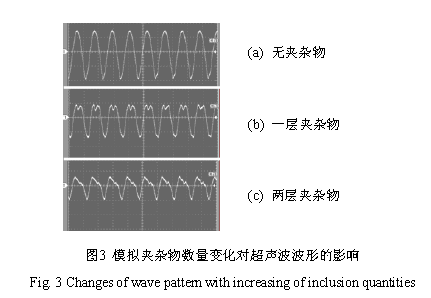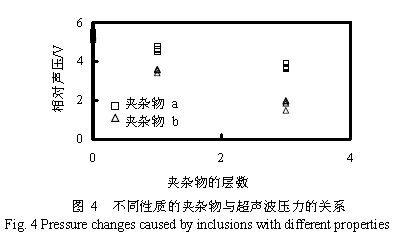当超声波频率为 32.5 kHz,探头距超声波发射面为47 mm 时,超声波随粒径为0.18~0.28mm 的聚乙烯塑料模拟夹杂物的浓度变化的实验结果如图5 所示。从图中可以看出,超声波的相对声压随着颗粒浓度的增加而减小;而且当夹杂物浓度变化时,超声波相对声压在夹杂物粒径相同的情况下随着浓度的变化可能是非线性的。在超声波频率为 32.5 kHz,探头距超声波发射面为79 mm 的实验条件下,当夹杂物浓度(重量比)为0.031%时夹杂物粒径的变化而引起的超声波强度变动的实验数据如图6 所示。从图中可以看出,相同夹杂物浓度的情况下,超声波声压随着粒径的增大而减小。另外,因夹杂物浓度过小,超声波波形并无明显的变化,这与前面实验一的结果有明显的差别。
3. 结论
通过水模型模拟实验,考察并对比了溶液中不同夹杂物对超声波传播规律的影响,对夹杂物粒径和浓度变化对超声波传播的影响也着重进行了考察,得到如下结论:
(1) 溶液中存在夹杂物时,超声波的强度都减小,波形也发生较大变化。当溶液中存在相同浓度、相同粒径的不同夹杂物时,超声波的衰减程度不同。
(2) 粒径相同的情况下,超声波的强度随着夹杂物浓度的增加呈非线性减小;浓度相同时,超声波声压随着夹杂物粒径的增大而减小,而且超声波对夹杂物浓度和粒径的变化反应灵敏。
以上的研究表明,可以根据超声波压力和波形的变化得出金属液中夹杂物的种类、大小和数量,因此利用超声波检测液态金属中金属及非金属夹杂物是有可能的。但是,需要指出的是,在实际应用中,需要对液态金属和夹杂物的种类和特性进行深入分析和比较。该研究为将来利用电磁超声波在线检测液态金属洁净度的研究提供了重要依据。
参考文献
[1] HERMAN J C, LEROY V. Influence of residual elements on steel processing and mechanical properties[J].Metal working and steel processing, Cleveland, 1996: 1-15.
[2] 赵坚, 赵琳. 优质钢缺陷[M]. 北京: 冶金工业出版社, 1991: 13-92.
ZHAO J, ZHAO L. Defects of high quality steel[M]. Beijing: Metallurgical industry press, 1991: 13-92. (inChinese)
[3] 白晓清,张林,李东辉,等. 超声波对流动液体中夹杂物去除效果的实验研究[J]. 东北大学学报: 自然科学版, 2002, 23(4): 348-351.
BAI X Q, ZHANG L, LI D H, et al. Effects of ultrasound on inclusion removal in flow fluid[J]. Journal ofNortheastern University: Natural science, 2002, 23(4): 348-351. (in Chinese)
[4] HATANAKA S, KUWABARA M, ASAI S. Design of ultrasonic field in liquid metal processing[J].Tetsu-to-Hagane, 2000, 86(9): 55-62.
[5] JIAN X, MEEK T T, HAN Q. Refinement of eutectic siliconPhase of aluminum A356 alloy usinghigh-intensity ultrasonic vibration[J]. Scripta Materialia, 2006, 54 (5): 893-896.
[6] KUMAR H, PARMAR A. Ultrasound promoted ZrCl4 catalyzed rapid synthesis of substituted 1, 2, 3,4-tetrahydropyrimidine-2-ones in solvent or dry media[J]. Ultrasonics Sonochemistry, 2008, 15(2): 129-132.
[7] MIYOSHI J, KIKUCHI Y, NOUMOTO O. Ultrasonic technique handbook[M]. Tokyo: Daily IndustryNewspaper Publication Company, 1983: 394-402.
[8] KAWAI S, WANG Q, IWAI K, et al. Generation of compression waves by simultaneously imposing a staticmagnetic field and a refinement of solidified structure[J]. Materials Transactions, 2001, 42(2): 275-280.
[9] WANG Q, MOMIYAMA T, IWAI K, et al. Non-contact generation of intense compression waves in a moltenmetal by using a high magnetic field[J]. Materials Transactions, JIM., 2000, 41(8): 1034-1039.
[10] WANG Q, IWAI K, ASAI S. Control of intensity and distribution of compression waves excited byalternating electromagnetic force[J]. Tetsu-to-Hagane, 2001, 87(8): 521-528.
[11] AMANO S, IWAI K, ASAI S. Non-contact generation of compression waves in a liquid metal by imposing ahigh frequency electromagnetic fields[J]. ISIJ International, 1997, 37(10): 962-966.Model study on in-situ detection of inclusion in liquid metalby ultrasonic wavesYuan Yi1, Wang Qiang1, Fan Kebo1, Gan Huiqi2, He Jicheng11. Key Laboratory of Electromagnetic Processing of Materials(Ministry of Education),Northeastern University, Shenyang (110004)
2. Zhe Jiang Wan Feng Motorcycle Wheel Co.Ltd, Xinchang, Zhejiang (312500)
Abstract
The possibility of using ultrasonic waves to in-situ detect the inclusions in liquid metals is researchedby a water model. The effects of inclusions with different properties on ultrasonic waves propagatingthrough water are examinedand compared. It is found that the intensity of ultrasonic waves decreasedand the wave pattern also changed obviously when there were inclusions in the solution. Furthermore,the changes mentioned above for different inclusions were not similar. The influences of concentrationsand particle sizes of inclusions on the diffusing of waves are also studied. The detected pressure of theultrasonic waves became smaller with the increasing of the inclusion concentration and particle sizes,and the fluctuations of the waves were sensitive to the changes of the above two factors. From theexperiment results, it can be concluded that acoustic waves can be used to detect the inclusions inliquid metal directly.
Keywords: application acoustics;ultrasonic detection; electromagnetic acoustic waves; cleanness ofmetal; inclusion; refining processes
作者简介:
苑轶(1980—),女,博士研究生;
王强,通信联系人,教授,E-mail:wangqiangks@yahoo.com.cn。





 空气耦合式超声波无损检测技术的
06-08
空气耦合式超声波无损检测技术的
06-08
 超声波测距系统
04-15
超声波测距系统
04-15
 超声波声速测量新方法
06-05
超声波声速测量新方法
06-05
 超声波探伤实验
09-24
超声波探伤实验
09-24
 超声波测距仪研究
06-03
超声波测距仪研究
06-03
 超声波在悬浮液中的衰减
06-09
超声波在悬浮液中的衰减
06-09
